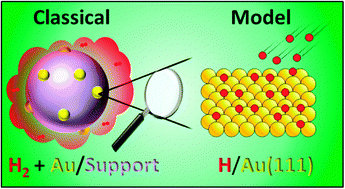Supported gold nanoparticles have recently been shown to possess intriguing catalytic activity for hydrogenation reactions, particularly for selective hydrogenation reactions. However, fundamental studies that can provide insight into the reaction mechanisms responsible for this activity have been largely lacking. In this tutorial review, we highlight several recent model experiments and theoretical calculations on a well-structured gold surface that provide some insights. In addition to the behavior of hydrogen on a model gold surface, we review the reactivity of hydrogen on a model gold surface in regards to NO2 reduction, chemoselective C![[double bond, length as m-dash]](https://www.rsc.org/images/entities/char_e001.gif) O bond hydrogenation, ether formation, and O–H bond dissociation in water and alcohols. Those studies indicate that atomic hydrogen has a weak interaction with gold surfaces which likely plays a key role in the unique hydrogenative chemistry of classical gold catalysts.
O bond hydrogenation, ether formation, and O–H bond dissociation in water and alcohols. Those studies indicate that atomic hydrogen has a weak interaction with gold surfaces which likely plays a key role in the unique hydrogenative chemistry of classical gold catalysts.
![[double bond, length as m-dash]](https://www.rsc.org/images/entities/char_e001.gif) O bond
O bond 